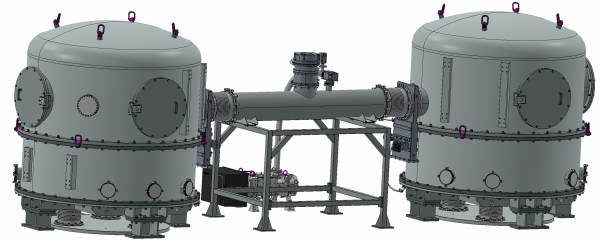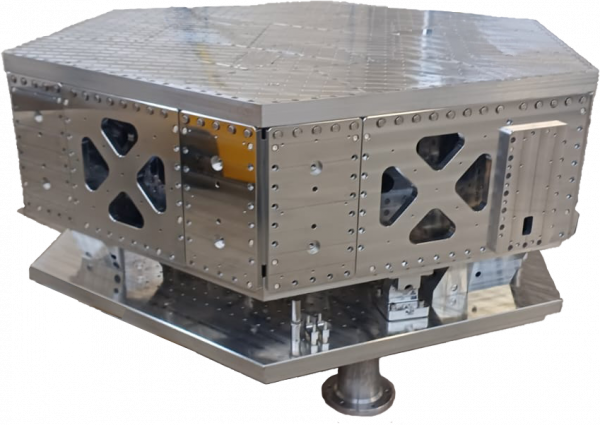Difference between revisions of "GEMINI"
| (2 intermediate revisions by the same user not shown) | |||
| Line 1: | Line 1: | ||
| − | [[File: | + | |
| − | The underground facility GEMINI is dedicated to the development of important vibration-isolation and control technologies for the Einstein Telescope and to test next-generation inertial sensors for the Einstein Telescope and the Lunar Gravitational-wave Antenna. | + | [[File:vacuum_system.png|600px|thumb|right|Drawing of the GEMINI vacuum system. The two chambers contain the suspended and stabilized platforms. The goal is to create the world's quietest platforms in terms of vibration noise in the 10mHz to 1Hz band.]] |
| + | The underground facility GEMINI is dedicated to the development of important vibration-isolation and control technologies for the Einstein Telescope and to test next-generation inertial sensors for the Einstein Telescope and the Lunar Gravitational-wave Antenna (LGWA). It consists of two in-vacuum mechanical structures as shown in the sketch. The mechanical structures are divided into two stages. The first stage is mounted to the ground, while the second stage is suspended from three maraging-steel spring blades. Three high-end low-frequency seismometers (Nanometrics T360 GSN) are used on each suspended platform to monitor its displacement. The control system of the platform uses coil actuators to counteract the observed displacement. | ||
Measurements with a laser interferometer will be used to suppress the relative motion between the two suspended platforms. This system is known as inter-platform control and is crucial for Einstein Telescope to facilitate control of its auxiliary interferometric degrees of freedom and to reduce stray-light noise. | Measurements with a laser interferometer will be used to suppress the relative motion between the two suspended platforms. This system is known as inter-platform control and is crucial for Einstein Telescope to facilitate control of its auxiliary interferometric degrees of freedom and to reduce stray-light noise. | ||
| + | |||
| + | A cryocooler will be available at one of the two GEMINI platforms to create a cold box where inertial sensors can be tested in a cryogenic environment. In this setup, the GEMINI platform can also act as an emulator of a cold lunar permanently shadowed region, which will be the deployment location of LGWA. | ||
| + | [[File:platform.png|600px|thumb|right|Photo of the mechanical structure of GEMINI's active isolation system.]] | ||
Latest revision as of 14:59, 27 March 2025
The underground facility GEMINI is dedicated to the development of important vibration-isolation and control technologies for the Einstein Telescope and to test next-generation inertial sensors for the Einstein Telescope and the Lunar Gravitational-wave Antenna (LGWA). It consists of two in-vacuum mechanical structures as shown in the sketch. The mechanical structures are divided into two stages. The first stage is mounted to the ground, while the second stage is suspended from three maraging-steel spring blades. Three high-end low-frequency seismometers (Nanometrics T360 GSN) are used on each suspended platform to monitor its displacement. The control system of the platform uses coil actuators to counteract the observed displacement.
Measurements with a laser interferometer will be used to suppress the relative motion between the two suspended platforms. This system is known as inter-platform control and is crucial for Einstein Telescope to facilitate control of its auxiliary interferometric degrees of freedom and to reduce stray-light noise.
A cryocooler will be available at one of the two GEMINI platforms to create a cold box where inertial sensors can be tested in a cryogenic environment. In this setup, the GEMINI platform can also act as an emulator of a cold lunar permanently shadowed region, which will be the deployment location of LGWA.

